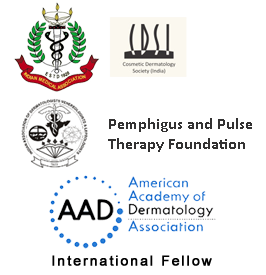Chemical peeling is a technique used to improve the appearance of the skin that is typically performed on the face, neck or back. In this treatment, a chemical solution is applied to the skin that causes it to "blister" and eventually peel off. The new, regenerated skin is usually smoother and less wrinkled than the old skin. The new skin is also temporarily more sensitive to the sun.
Dermatologists have used various peeling agents for the last 50 years and are experts in performing multiple types of chemical peels. A thorough evaluation by a dermatologist is imperative before embarking upon a chemical peel.
What can a chemical peel do?
Chemical peeling is often used to treat fine lines and all kinds of pigmentation. Wrinkles caused by sun damage, aging and hereditary factors can often be reduced or even eliminated with this procedure. However, sags, bulges and more severe wrinkles do not respond well to peeling and may require other kinds of cosmetic surgical procedures such as a botulinum toxin injection or soft-tissue filler.
Mild scarring and certain types of acne also can be treated with chemical peels. In addition, pigmentation of the skin in the form of sun spots, age spots, freckles and skin that is dull in texture and color may be improved with chemical peeling.
Chemical peeling may be combined with laser resurfacing, dermabrasion or soft-tissue fillers to achieve cost-effective skin rejuvenation customized to the needs of the individual patient. Generally, fair-skinned and light-haired patients are ideal candidates for chemical peels. Darker skin types may also experience good results depending upon the type of skin problem encountered.
How are chemical peels performed?
After a detailed history and appropriate medical treatment, we choose the right type of 'peel' for our patient. Prior to peeling, instructions may include the elimination of certain drugs and the preparation of the skin with topical pre-conditioning medications.
A chemical peel can be performed in the clinic as an outpatient procedure. At the time of treatment, the skin is thoroughly cleansed with an agent that removes excess oils, and the eyes and hair are protected. One or more chemical solutions – an alpha hydroxy acid, such as glycolic acid, salicylic acid, or lactic acid; trichloroacetic acid (TCA); or carbolic acid (phenol) – are used. During a chemical peel, the physician applies the solution to small areas on the skin. These applications produce a controlled wound, enabling new, refreshed skin to appear. Most patients experience a warm to somewhat hot sensation that lasts about five to 10 minutes, followed by a tingling sensation.
What should be expected after treatment?
Depending upon the type of peel, a reaction similar to a sunburn occurs following a chemical peel. Superficial peeling usually involves redness, followed by scaling that ends within three to seven days. It is important to avoid overexposure to the sun after a chemical peel since the new skin is fragile and more susceptible to complications. Proper follow-up care to reduce the tendency to develop abnormal skin color after peeling is prescribed. 3-4 such sessions at an interval of 3-4 weeks are recommended. Newer peels are available for concerns like dark circles, peri oral pigmentation (pigmentation around the mouth), dark lips, dark elbows and stretch marks or striae.


